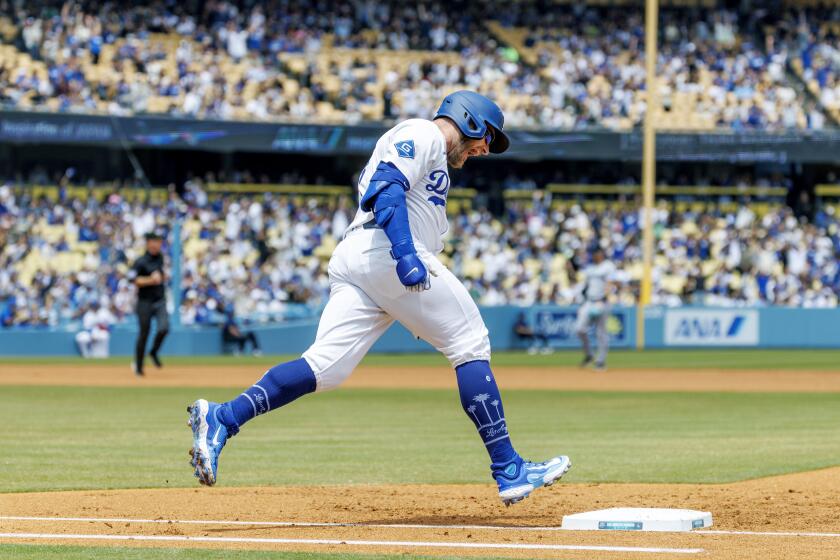Dodgertown Is Shadow of Its Former Self : Baseball: It’s a rude awakening for players with major league experience expecting major league treatment.
- Share via
VERO BEACH, Fla. — One of the few men with absolute power to end baseball’s lockout fitted his key into the deadbolt.
“Like I said,” remarked the official as he opened the door to the Dodgers’ spring clubhouse. “Empty.”
The room didn’t look or feel like baseball. It didn’t even smell like baseball.
It was crammed with empty lockers--metal ones lining the walls, wooden ones scattered and stacked across the middle of the floor. Underneath the clutter was a pile of long boxes, taped shut so one could only assume they were bats. Draped across a table were heaps of dark blue towels. This was not a locker room, but a storage room.
“Strange, isn’t it?” asked the official, who wished to remain anonymous. “This room could belong to anybody.”
Try spirits.
“This place is a ghost town,” said Dodger minor leaguer Bill Bene, one of 57 prospects who began spring training Friday in the invisible shadows of the missing 38 major league Dodger players and their five coaches. On this first scheduled day of workouts at Dodgertown, the lockout of baseball’s major leaguers by the owners became both official and noticeable.
The minor leaguers were scattered among five fields. The buildings were strangely quiet as they baked in the mid-afternoon sun. Dodgertown Theatre got into the dispirit of things Friday night by showing “Scrooged.”
And the fans said the heck with it. Last year, on the first day of workouts, observers estimated that more than 500 people crowded the Dodgertown sidewalks and grassy paths. Friday, the total was closer to 30.
They came not because they wanted to cheer, but because they were curious. They did not ask for autographs, or try to shake hands. It became apparent most of them were not sure what they were watching.
This was because, for the first time in recent years, the minor leaguers did not wear the white major league jerseys with their names on the back. They all wore minor league blue, with no identification other than a number. It was as if the Dodgers wanted nobody to forget the lockout, including those players with major league experience who had been invited here and promised that they would be treated like major leaguers.
“They were talking about having to rush my big league jersey down from Los Angeles, and now I get here and everything has changed,” pitcher Mike Munoz said. “Everyone is treated the same, everyone is treated like a minor leaguer, no matter what. It’s different than I thought.”
Said Billy Bean, another major league prospect: “They want to make sure everybody knows this is a minor league camp. It brings all of us back to earth.”
For those minor leaguers who thought they would be receiving pointers and pine tar from their favorite millionaires, it was an even bigger disappointment.
“This is kind of a drag,” said Eric Karros, a former UCLA star scheduled to start this season at double-A San Antonio. He hit several long batting practice home runs in front of minor league coaches, then yawned.
“It doesn’t seem like we’re going at it like last year,” he said. “Not the same excitement. It’s like we’re just waiting for the big league guys to show up.”
So are Dodger officials. While Vice President Fred Claire and Manager Tom Lasorda have been cleared to attend, they will not arrive until next week. Even the Dodger major league scouts have been asked to stay away.
“That makes sense,” scout Mel Didier said from his Texas home. “What do I scout when I get there? An empty field?”
Lasorda wasn’t taking things so patiently.
“I’m just sitting here waiting and hoping,” Lasorda said. “I just want to get the word that, hey, this thing is over with and we can get started. We’ve got a lot of question marks on this team. We have a lot of work to do.”
The delay may force Lasorda to carry more than the usual 10 pitchers, simply because the starters won’t be able to pitch as long.
“This will test our bullpen, because the starters really need six weeks of spring training,” Lasorda said. “If they don’t get it, they might only be able to go five or six innings in their first few starts. We’ll need more guys down in the bullpen.”
Such a decision would affect the fate of pitchers such as Tim Crews, Mike Hartley, Pat Perry and Munoz, all of whom could be fighting for the fifth and final spot in the bullpen.
With Lasorda missing, probably the most noticeable man at camp was not a player or a coach, but muscular John Skinner, who wears a shirt and tie--and a beeper. He was seen peeking around corners and checking fields, with a list of non-roster players under his arm and a frown on his face. He said he worked for the commissioners’ office, but would offer no further comment.
“Aw, they just sent somebody here to make sure everybody is following the rules,” said Guy Wellman, the minicamp director. “Every camp got one of those guards. This ain’t your usual year.”
More to Read
Are you a true-blue fan?
Get our Dodgers Dugout newsletter for insights, news and much more.
You may occasionally receive promotional content from the Los Angeles Times.










